AMD's DTX Form Factor: Smaller PCs for Everyone?
by Anand Lal Shimpi on October 22, 2007 1:00 AM EST- Posted in
- Cases/Cooling/PSUs
The Reference Platform
Why are we even talking about DTX today? AMD sent us its first DTX reference platform, showing us that actual progress had been made on the standard since its announcement at CES in 2007.
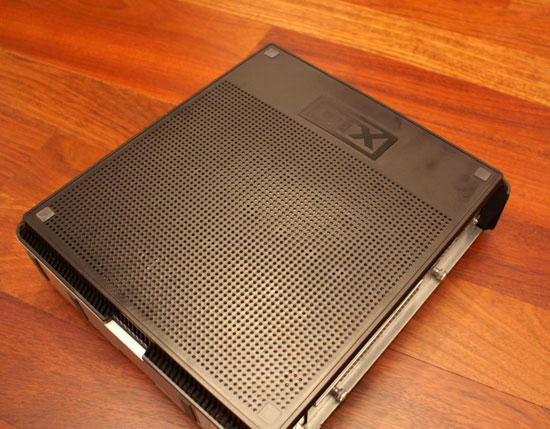
The system uses a reference AMD 690G DTX motherboard, AMD Athlon X2 BE-2350 (45W Athlon 64 X2 running at 2.1GHz), 1GB of DDR2 memory, with a standard 3.5" hard drive, slim form factor DVD drive and a 250W power supply.
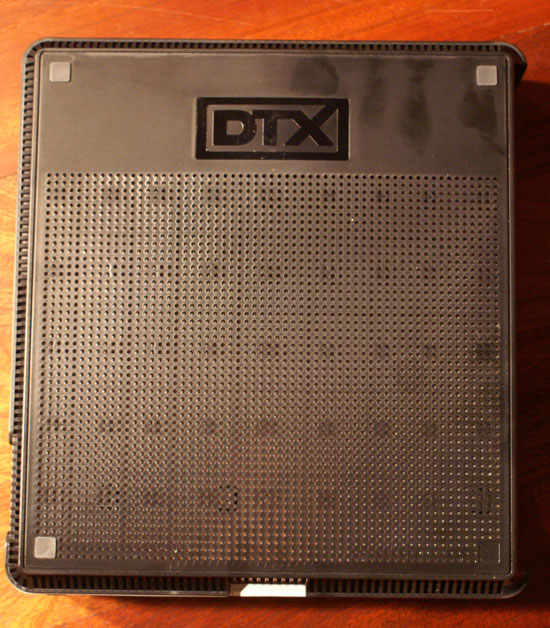


The system itself is quite compact, albeit not particularly stylish. It works and we already know how the Athlon X2 BE-2350 performs so there are no complaints there.
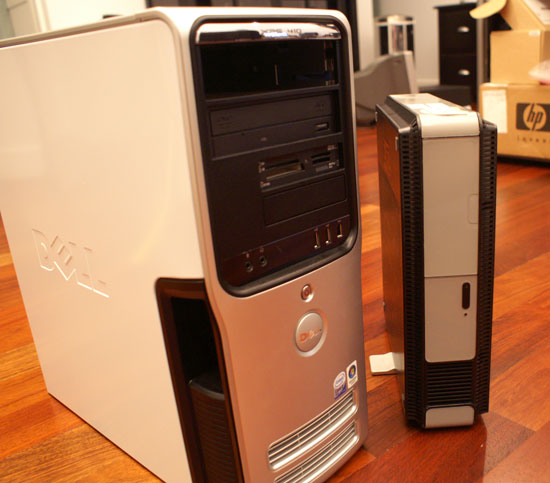
With a power supply fan and CPU fan running, it's reasonably quiet but obviously not silent. AMD mentioned that the prototype chassis we received was missing a vent over the power supply and thus would be louder than normal. We noticed that during usage the fans spun up to a level too high for use in a quiet HTPC environment. AMD cautioned us against drawing any conclusions based on this prototype's performance, and we tend to agree (although that does mean that the reference design is good for little more than some nice pictures).

The removable flap covers the DVD drive, but isn't hinged, it just comes off...thankfully this is a prototype
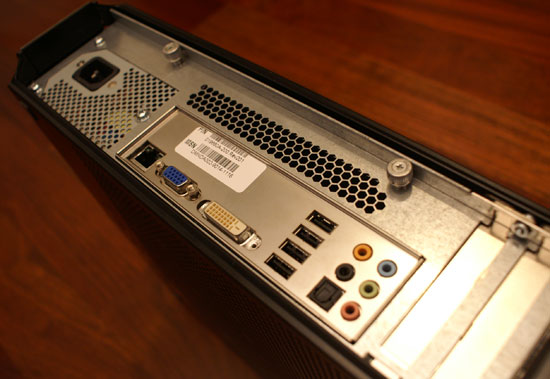
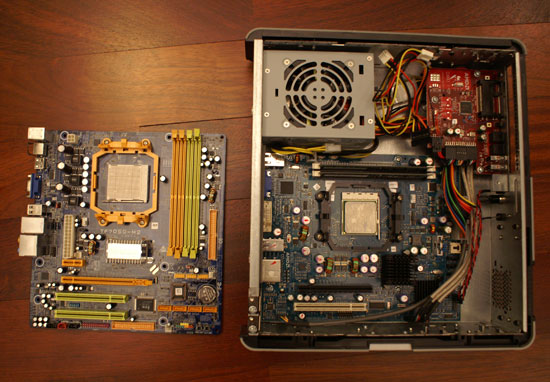
A micro ATX motherboard (left) vs. DTX platform (right)
Obviously the performance of the reference design doesn't really matter in the grand scheme of things, it's really a question of how well the designs that hit the market in the future fare.










37 Comments
View All Comments
defter - Monday, October 22, 2007 - link
Where I can find 500GB 2.5" HDD for $100?
For most of the people size isn't that important and they do not want to pay extra for a small size.
Calin - Monday, October 22, 2007 - link
Forget about price, where can I find a 2.5" hard drive at 750GB?Also, with a dual slot cooled graphic card, you are out of luck for SLI on a micro ATX board
Myrandex - Monday, October 22, 2007 - link
100% Liar Face detected.http://www.theinquirer.net/en/inquirer/news/2006/0...">http://www.theinquirer.net/en/inquirer/...6/03/13/...
I have that board, and it is awesome. It is keeping me from upgrading as I have never found a mATX board as good as that one for either AM2+ or Core2/4/1024 Duo chips.
I actually wish someone would make that with a socket AM2+ socket on there so that I could take the same board with the same Chipset and be Phenom ready (or someone make a Intel CPU compatible version plz!)
themadmilkman - Monday, October 22, 2007 - link
Okay, then show us an mATX board that allows you to run at 16x in SLI using double-slot cards, because that one does not. According to the article you linked, they only run at 8x when using the outer slots.sprockkets - Tuesday, October 23, 2007 - link
yeah, but I dare you to show the improvement over 8x.Gamer systems have to be ATX. The video cards are huge, and besides, it is all about show, i.e. windows, lights, UV, aluminum, etc.
kyp275 - Monday, October 22, 2007 - link
Not quite, it all depends on what you're using your PC for.For many moderate to power users, cooling is a big issue, and when you stick all that power-hungry CPU/GPUs into a small case, effective cooling becomes extremely difficult to achieve.
I'm currently running a e6600 with a single 8800gts card in a P182 case, a full size mid-tower, and it's barely big enough to fit all the components, their cooler, leave room for optimal airflow, and I'm not even running SLI or crossfire. There's a reason why you don't see any high-end machines in small-form factors, they simply don't work with today's cooling methods.
Price is also another issue. While your right that not being the standard has to do with the price premiums, there are also physical limitations that goes into smaller parts such as a hard drive. There's simply less physical area in the 2.5" drives to store information compared to their 3.5" counterpart, and unless you can come up with a way to defy the law of physics, that's just the way it's going to be.
BansheeX - Monday, October 22, 2007 - link
Don't you see the fallacy in that viewpoint, though? In five years, you'll be saying 2TB on a 2.5 isn't enough when you can get 4TB on a 3.5. And if we had double-ATX sized computers as a standard, you'd be having the same grievances about the ATX standard. "Oh no, I can't use octo-SLI or a 1500w power supply! Noooooo!" The heat and cost issues people are bringing up have everything to do with the fact that costs are lower insatiable appetite for power. Multiple-video cards is a joke and always has been. The industry standard shouldn't be ATX with smaller form factors labeled as for the "enthusiast HTPC crowd." Micro-ATX should be the standard with ATX being the less common "enthusiast" platform for people who are insatiable enough to buy into SLI.kyp275 - Monday, October 22, 2007 - link
If in 5 years i say that 2TB on a 2.5" isn't enough, it'll be because it ISN'T enough for my usage. It wasn't that long ago when 160gb or 320gb was more than enough for me, but the increasing size of many media files (lossless audio, HD vid, larger games etc.) means that those sizes are no longer enough, at least for my need. And as long as 2.5" drives continue to be more expensive and slower than their 3.5" counterpart, people will prefer the 3.5" drives.
Unless you want to pay for mine, that is :P
It's the softwares that dictates what hardwares we use, I'd imagine most people don't choose what hardwares to use for the sake of the hardwares, except maybe the bench-mark enthusiast crowd.
Basically, your arguments are ignoring too many things. People will not get "octo-SLI" or a 1500w PSU unless there's a need, real or perceived, being driven by their particular application. As for heat issues, that's purely the product of the way our technology works today. If you have a problem with that, take it up with the laws of thermodynamic.
and why is that? give me a reason why small form factors should be the standard. ATX isn't just for people who want to have SLI, like I said in a post earlier, I'm running a single 8800gts in a full size mid-tower, and it's just barely enough. There's simply no way to jam all the stuff I have in that PC into a SMF box without the stuff overheating all the time.
and that's assuming I can even jam all that stuff in there in the first place.
bupkus - Monday, October 22, 2007 - link
45nm--->32nm, etc.
I don't thing BansheeX is suggesting that you be forced to cram your high powered system into a tiny case. I think that market trends to miniaturization for all and especially for the bulk of users is inevitable.
BansheeX - Monday, October 22, 2007 - link
Exactly. All I'm trying to get across here is that when 95% of the market would find matx computers with current capacity 2.5 HDs totally sufficient, staying with ATX as the industry standard just seems foolish. Look at all of the things that have changed to allow for this. Floppies are dead. Onboard ethernet is now good and standard, freeing up a slot that always used to be taken. Onboard audio got better, making sound cards unnecessary for most. 2.5 HDs got massive and storage density and 8mb cache increased their speeds dramatically even at 5400rpm. That and they barely get warm to the touch and they make virtually no sound, in turn making them more reliable. It's a serious improvement that will only continue to get better and cheaper if 3.5 gets canned. I honestly believe that 3.5 hard drives are an unnecessary dinosaur format. Macs and consoles are 100% correct to choose 2.5 while people who only think about size/cost continue to perpetuate 3.5's just as they would an even cheaper, larger, noisier and more power-hungry 5" HD if one existed.So yes, it's positively peculiar to me that we continue to see things like 5-expansion ATX persist as the norm while smaller boards are relegated for niche markets. I can't believe how resistant the PC market is to change. Christ, I still have parallel and serial ports on the back of my new motherboard. Fifteen years later... WHY ARE THESE HERE. I don't care how many people bitch and moan, the industry needs to grow some balls like they did with SATA.